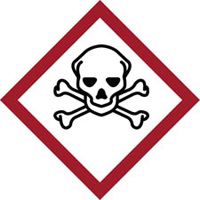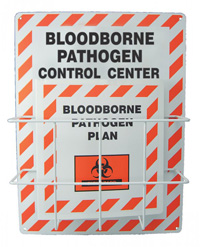



Find all of your laboratory and workplace safety supplies at Safety Emporium!
 Activated Charcoal |
 Glossary Index |
 Administrative Controls |
| MSDS Topics |
Free Sites | FAQ's | Regulations | Glossary | Software | Suppliers |
| Books | Forum | Poll | Fun stuff | Quiz | Store | |
| Understand your MSDS with the MS-Demystifier | Search ALL our MSDS info | |||||

Get your GHS-compliant labels and signs from Safety Emporium.
Acute toxicity describes the adverse effects resulting from a single exposure to a substance. Under Paragraph A.1.1. of Appendix A to to 29 CFR 1910.1200, the OSHA Hazard Communication Standard (HCS 2012), acute toxicity is defined specifically as adverse effects occurring following oral or dermal administration of a single dose of a substance, or multiple doses given within 24 hours, or an inhalation exposure of 4 hours.
Acute Toxicity is one of the ten health hazard classifications under HCS 2012. Manufacturers are required to research the available scientific literature for data establishing acute toxicity per Paragraph A.1.2.1 of Appendix A, but are not required to perform any testing when performing the hazard classification process.
Per Paragraph A.1.2.3 of Appendix A:
The preferred test species for evaluation of acute toxicity by the oral and inhalation routes is the rat, while the rat or rabbit are preferred for evaluation of acute dermal toxicity. Test data already generated for the classification of chemicals under existing systems should be accepted when reclassifying these chemicals under the harmonized system. When experimental data for acute toxicity are available in several animal species, scientific judgment should be used in selecting the most appropriate LD50 value from among scientifically validated tests.
Human tests for acute toxicity are not performed because of ethical and legal prohibitions. The U.S. Environmental Protection Agency (EPA) describes the following methods for determination of acute toxicity:

Laboratory operations are a breeze with Ohaus analytical balances from Safety Emporium.
In OSHA's adoption of the GHS model, does not include the GHS's acute toxicity Category 5. This means that if the manufacturer's survey of the scientific literature (or testing, although none is required) determines that a substance meets the criteria for GHS Category 5, the acute toxicity classification of this material under the HCS would be a hazard not otherwise classified (HNOC) rather than Acute Toxicity Category 5. While the HNOC finding must be reported on the Safety Data Sheet (SDS), an HNOC finding is not one of the pieces of information that must appear on the container label (although the manufacturer is include it if they wish). This scenario is another great example of why one should always read the SDS before working with a new material - labels present only the most important hazards and precautions whereas SDS's are comprehensive.
Toxic effects (if any) will be noted in Section 11 (toxicological information) of the SDS. Any HNOC would be reported in Section 2 (Hazard(s) identifications) of the sheet.
Acute toxicity helps workers understand the health consequences from a single exposure to a chemical. For example, hydrogen cyanide is a highly toxic substance; acute exposure at relatively low doses can result in death.
Acute toxicity differs from chronic toxicity, which describes the adverse health effects from repeated (lower level) exposures to a substance over a longer period (months to years).

Safety Emporium carries bloodborne pathogen compliance centers and related compliance materials.
See also: Chronic toxicity, cyanide, LD
Additional definitions from Google and Onelook.
Entry last updated: Wednesday, February 16, 2022. This page is copyright 2000-2025 by ILPI. Unauthorized duplication or posting on other web sites is expressly prohibited. Send suggestions, comments, and new entry desires (include the URL if applicable) to us by email.
Disclaimer: The information contained herein is believed to be true and accurate, however ILPI makes no guarantees concerning the veracity of any statement. Use of any information on this page is at the reader's own risk. ILPI strongly encourages the reader to consult the appropriate local, state and federal agencies concerning the matters discussed herein.